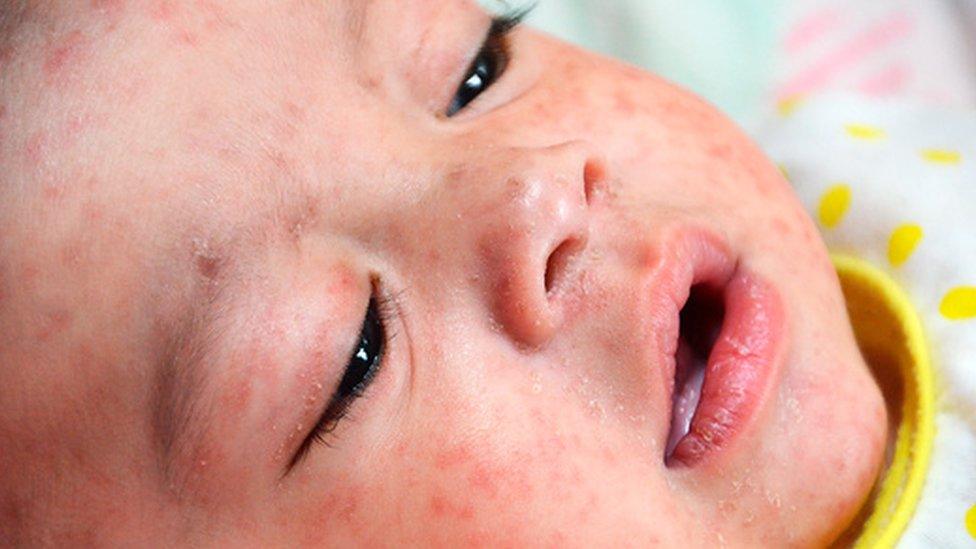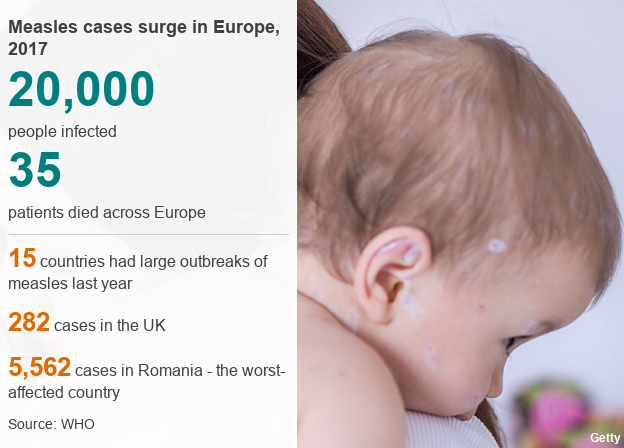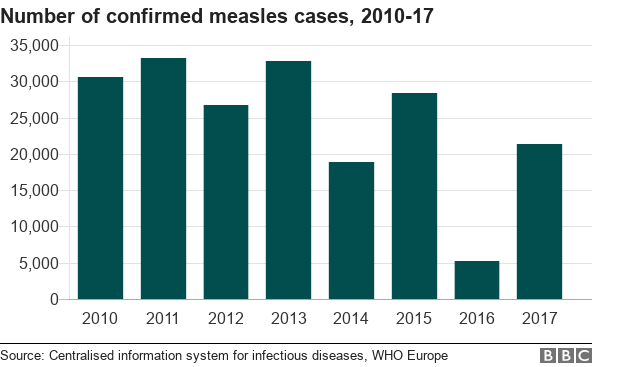WHO warning as European measles rate jumps from record low
- Published

Unvaccinated young children are at highest risk of contracting measles
Europe has seen a big surge in measles cases in 2017, which the World Health Organization says is a tragedy after a record low of 5,273 cases in 2016.
Cases increased four-fold, with more than 20,000 people affected and 35 deaths.
Fifteen European region countries, including the UK, had large outbreaks. Measles cases were highest in Romania, Italy and Ukraine.
People shunning vaccination is part of the problem, say experts.
Although research published 20 years ago about a possible link between the MMR vaccine and autism has been discredited, the scare it created damaged some people's trust of the vaccine.
Measles is a highly infectious viral illness that can be deadly.
The MMR vaccine can prevent it.

More of our most-read stories:


The WHO says there have been declines in overall routine immunisation coverage, as well as consistently low coverage among some marginalised groups and interruptions in vaccine supply or underperforming disease surveillance systems.
Dr Zsuzsanna Jakab, from the WHO, said: "Every new person affected by measles in Europe reminds us that unvaccinated children and adults, regardless of where they live, remain at risk of catching the disease and spreading it to others who may not be able to get vaccinated.
"This short-term setback cannot deter us from our commitment to be the generation that frees our children from these diseases once and for all."
The UK saw 282 cases in 2017, linked to the continuing outbreak in Europe.
The UK recently achieved WHO measles elimination status, meaning that for the past few years the number of cases has been low enough to stop the disease circulating around the country.
The overall risk of measles to the UK population is low, but due to ongoing measles outbreaks in Europe, cases in unimmunised individuals and limited onward spread can occur.
A few weeks ago, Public Health England warned about measles cases in several regions of England.
At the end of January 2018, there were 51 confirmed cases in the West Midlands.

The vaccine is given as two doses to very young children as part of the NHS childhood vaccination programme.
Adults and older children can be vaccinated at any age if they have not been fully immunised before.
To prevent outbreaks, WHO says 95% of the population should be immunised. In the UK, coverage was 91.6% among young children in 2016-17.
Measles symptoms include a runny nose, sneezing and cough, sore, red eyes, a high temperature and, after a few days, a red-brown blotchy rash.
Why are measles rates so high?
The main reason behind the sharp rise in measles cases is low immunisation coverage, the WHO says. They say a lack of coverage increases the risk of the virus spreading when it is brought in from abroad.
But some European countries have seen an exceptionally high increase in rates.
Romania is fighting its worst measles outbreak in decades. There were more than 5,500 cases last year, partly due to a shortage of the vaccine and poor healthcare facilities. It is also thought that the country's large Roma population, who often live in severe poverty, are at particular risk of contracting and spreading the virus.
Italy had the second highest number of measles cases in Europe last year.

In recent years, a loose group of campaigners against vaccinations, dubbed the anti-vax movement, has dissuaded Italians from opting in to immunisations by citing supposed risks. In response, the government ruled that children must be vaccinated against 12 common illnesses before they can enrol for state-run schools.
This law is one of the key issues in the upcoming March 4 elections and some people are calling for it to be scrapped.
Ukraine is also struggling with a measles outbreak, with almost 5,000 cases recorded in 2017. The WHO says countries that are experiencing conflict are at an increased risk of measles due to damaged health services and infrastructure.
Measles cases across Europe in 2017
Romania - 5,562 cases
Italy - 5,006 cases
Ukraine - 4,767 cases
Greece - 967 cases
Germany - 927 cases
Serbia - 702 cases
Tajikistan - 649 cases
France - 520
Russian Federation - 408
Belgium - 369
UK - 282
Bulgaria - 167
Spain - 152
Czech Republic - 146
Switzerland - 105
- Published16 January 2018
